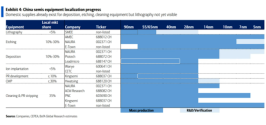since this is a semiconductor thread so i can't comment about Turbofan/Nacelle with images.. btw its Turbofan not Turbojet.Not sure about the source but 65nm falls under the varification until 28nm as highlighted. We will don't know about the mass usage of that 65nm Lithography machine in Fabs.
On a slight detour (which is good every now and then), anyone know very big major Choke points China still have wrt Western Countries. The major ones I can think of are the EUV, ISA (because LoongArch is not wide spread), TurboJets, Nacelle.
I'm aware for each of them a replacement is well under development. Just want to know about other major Choke points.
Since 2019 I kept thinking, fate of the global South depends on China acquiring EUVL. But imagine, if China can breakthrough these choke points the global South can afford them much more easily because of China economy of scale. EV, Solar are the perfect example. Now imagine if China can mass produce C919 like those 2. We don't have to rely on unsafe, expensive Boeing and inefficient Airbus for Air Transportation
if you have little more time, you can visit the Engine thread. we regularly do post updates and development. WS-20 and CJ-1000 these two high bypass turbofan engines currently in production. Nacelle has been solved even back in 2021.. so these have become outdated information.
thank you..



